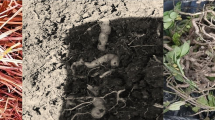Abstract
The present study deals with antibacterial activity of leaf and fruit parts of Ficus racemosa plant. Phytochemical analysis revealed alkaloids, flavonoids, phenols that contributed for higher antioxidant and antibacterial activity. The fruit exhibited significant inhibition when compared with leaf. Bacteria from wounds of diabetic patients were isolated and identified as Staphylococcus spp., Pseudomonas spp., Klebsiella spp. and Escherichia coli. MIC for all the three (Ethanol, toluene and ethyl acetate) extracts was performed against wound isolates. Among all wound bacteria tested Staphylococcus spp. showed lowest MIC (0.07 mg/ml) with toluene extract of fruit. The MIC for E. coli and Pseudomonas spp. was found to be 0.15 mg/ml and for Klebsiella spp. (0.31 mg/ml).The MIC 0.625 mg/ml was obtained for toluene extracts of leaf against Staphylococcus spp. and Klebsiella spp. Antibacterial study revealed that the extracts of leaf and fruit exhibited good inhibition activity against wound isolates. Study of well diffusion assay of Ficus racemosa extract revealed that 75 and 100 µg/ml concentration was found to have significant control over wound pathogens. Highest inhibition was obtained for Staphylococcus spp. and Klebsiella spp. with fruit extract with a zone of inhibition of 26 ± 0.10 and 24 ± 0.13 mm, respectively at 100 µg/ml. Toluene extract of fruit had higher antioxidant activity with IC50 of 0.75 µg/ml followed by ethanol extract 1.42 µg/ml and correlated with antibacterial activity. Thus, this study proved that leaf and fruit extract have significant antibacterial activity and hence it can be used for a therapeutic purpose.
Similar content being viewed by others
References
Beckert S, Witte M, Wicke C, Königsrainer A, Coerper S (2006) A new wound-based severity score for diabetic foot ulcers: a prospective analysis of 1,000 patients. Diabetes Care 29:988–992
Chowdhary N, Kaur M, Amarjeet S, Kumar B (2014) Wound healing activity of aqueous extracts of Ficus religiosa and Ficus benghalensis leaves in rats. Indian J Res Pharm Biotechnol 12:1071–1081
Cui JL, Guo TT, Ren ZX, Zhang NS, Wang ML (2015) Diversity and antioxidant activity of culturable endophytic fungi from alpine plants of Rhodiola crenulata, R. sangusta, and R. sachalinensis. PLos One J 4(2):423–465
Dimple SM, Bhaven C, Kataria B, Sunita BC (2012) Wound healing and anti-inflammatory activity of extract of Ficus racemosa Linn. bark in albino rats. Int J Basic Clin Pharmacol 1(2):111–115
Dorman HJ, Bachmayer O, Kosar M, Hiltunen R (2004) Antioxidant properties of aqueous extracts from selected Lamiaceae species grown in Turkey. J Agric Food Chem 52:762–770
Farrag HA, Rehim AH, Hazaa MM, Sayed AS (2016) Prevalence of pathogenic bacterialisolates infecting wounds and their antibiotic sensitivity. J Infect Dis Ther 4:5
Galal A, Askari L (2013) In vitro antimicrobial activity of aqueous and ethanolic extracts of leaves of Ficus carica collected from five different regions of Morocco. J Mater Environ Sci 4:33–38
Hisanori A, Kazuyasu F, Osamu Y, Takashi O, Keiji I (2001) Antibacterial action of several tannins against Staphylococcus aureus. J Antimicrob Chemother 48:487–491
Holt JG, Krieg NR, Sneath PHA, Staley JT, Williams ST (1994) Bergey's manual of determinative bacteriology, 9th edn. William and Wikin Company, Baltimore
Hossain S, Sayeed A, Uddin N (2014) In-vitro antimicrobial activity of methanolic extract of Ficus racemosa Linn. fruits. J Sci Innov Res 3(4):446–449
Kaur S, Mondal P (2014) Study of total phenolic and flavonoid content, antioxidant activity and antimicrobial properties of medicinal plants. J Microbiol Ex 1(1):5
Khaleel AI, Sijam K, Rashid TS, Ahmad KB (2016) Phytochemical determination and antibacterial activity of Punica granatum peel extracts against plant pathogenic bacteria. Am J Plant Sci 7:159–166
Kirankumar S, Umesh MK, Ramesh L (2013) Phytochemical screening and antimicrobial activities of Ficus glomerata Roxb fruit extracts. Int J Pharm Pharmaceut Sci 5:372–375
Kumari I (2018) A study of the antimicrobial effect of Euphorbia hirta L. against Escherichia coli. Vegetos 31(3):123–125
Mehta K, Patel BN, Jain BK (2013) Phytochemical analysis of leaf extract of Phyllanthus fraternus. Res J Recent Sci 2:12–15
Nair R, Chanda SV (2007) Antibacterial activities of some medicinal plants of the western region of India. Turk J Biol 31(4):231–236
Pandit R, Phadke A, Jagtap A (2010) Antidiabetic effect of Ficus religiosa extract in streptozotocin-induced diabetic rats. J Ethnopharmacol 128(2):462–466
Pinzur MS, Slovenkai MP (2005) Guidelines for diabetic foot care: recommendations endorsed by the Diabetes Committee of the American Orthopaedic Foot and Ankle. Soc Foot Ankle Int 26:113–119
Shaik G, Sujatha N, Mehar SK (2014) Medicinal plants as source of antibacterial agents to counter Klebsiella pneumonia. J Appl Pharm Sci 4(1):135
Soni N, Mehta S, Satpathy G, Gupta RK (2014) Estimation of nutritional, phytochemical, antioxidant and antibacterial activity of dried fig (Ficus carica). J Pharma Phyto 6(2):158–165
Tariq AL, Reyaz AL (2012) Phytochemical analysis of Camellia sinensis leaves. Int J Drug Dev Res 4:311–316
Tepe B, Daferera D, Sökmen M, Polissiou M, Sökmen A (2004) In vitro antimicrobial and antioxidant activities of the essential oils and various extracts of Thymus eigii M. Zohary et P. H. Davis. J Agric Food Chem 52:1132–1137
Vazir J, Inamdar P, Desai S, Patel D, Meshram D (2014) Phytochemical screening and in vitro antibacterial activity of Camellia sinensus. Indo Am J Pharm Res 4:1158–1162
Vedavathy S, Mrudula V, Sudhakar A (1997) A tribal medicine in Chittoor district. Andhra Pradesh, India, Vedams E Books (P) Ltd., New Delhi
Verma P (2012) Antibiotic sensitivity treatment for Gram positive bacteria isolated from pus sample. Bull Environ Pharmacol Life Sci 1:3–6
Acknowledgements
The researchers are thankful to the Head of the Department, Principal and Management of K.S.R. College of Educational Trust, Tiruchengode, Tamil Nadu, India. We also acknowledge DST-FIST Grant no. 368 for infrastructural support.
Author information
Authors and Affiliations
Corresponding author
Additional information
Publisher's Note
Springer Nature remains neutral with regard to jurisdictional claims in published maps and institutional affiliations.
Rights and permissions
About this article
Cite this article
Bagyalakshmi, B., Nivedhitha, P. & Balamurugan, A. Studies on phytochemical analysis, antioxidant and antibacterial activity of Ficus racemosa L. leaf and fruit extracts against wound pathogens. Vegetos 32, 58–63 (2019). https://doi.org/10.1007/s42535-019-00007-6
Received:
Revised:
Accepted:
Published:
Issue Date:
DOI: https://doi.org/10.1007/s42535-019-00007-6




